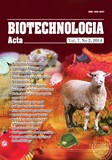ISSN 2410-7751 (Print)
ISSN 2410-776X (Online)

"Biotechnologia Acta" v. 7, no 2, 2014
https://doi.org/10.15407/biotech7.02.086
Р. 86-91, Bibliography 19, Ukrainian.
Universal Decimal classification: 582.998.1-119.2
M. M. Marchenko, А. E. Shelifist, L. М. Cheban
Phedkovitch Chernivtsy National University, Chernivtsy, Ukraine
Using the UV- and IR-spectroscopy methods in the plantstuff of Saussurea discolor (Willd.) DC. and S. porcii Degen, that are infrequent species of the genus of Saussurea DC., the existence of the sesquiterpene lactones in them was determined. Similar results for the plants cultivated in vitro were received. The contents of the sesquiterpene lactones are approximate to the same ones in the intact plants. It was found as well that the plants of S. discolor have their higher total content.
We elaborated the separation criterions (under 5-days extraction of chloroform), purification (using the adsorption chromatography column) and fractionation (applying thin layer chromatography) for the amounts of the sesquiterpene lactones. By thin layer chromatography there were detected the qualitative differences of their spectrum for the explants of plants, grown in vitro and for the S. discolor and S. porcii wild plants. The plant material of both investigated species differs besides by the quantitative content of the main components of the sesquiterpene lactones. All the investigated materials showed maximum amounts of Rf 0,36 and 0,95 components.
By diffusion in agar method the existence of the antimicrobial activity of the sesquiterpene lactones was detected. The test-system was Bacillus subtilis. This property was conditioned mainly by the action of the components of Rf 0,36 and 0,95.
The results give evidence for the ability of S. discolor and S. porcii to synthesize the sesquiterpene lactones. The cultivated in vitro plants could be as their sources. So the sesquiterpene lactones of S. discolor and S. porcii have the antimicrobial activity.
Key words: Saussurea discolor (Willd.) DC., S. porcii Degen, sesquiterpene lactones, thin layer chromatography, antimicrobial activity.
© Palladin Institute of Biochemistry of the National Academy of Sciences of Ukraine, 2014
References
L. Red List of Vascular Plants of the Carpathian Mountains. Lviv: State Museum of Natural History, NAS of Ukraine. 2002, 29 p.
2. The Red Book of Ukraine. The plantage ed. by J. P. Dіduha. Kyiv: Globalconsulting. 2009, 900 p. (In Ukrainian).
3. Zhang S., Won Y. K., Ong Ch. N., Shen H. M. Anti-cancer potential of sesquiterpene lactones: bioactivity and molecular mechanisms. Cur. Med. Chemistry-Anti-Cancer Agents. 2005, 5(3), 239–249.
https://doi.org/10.2174/1568011053765976
4. Choi S. Z., Choi S. U., Lee K. R. Cytotoxic sesquiterpene lactones from Saussurea calcicola. Arch. Pharm. Res. 2005, 28(10), 1142–1146.
https://doi.org/10.1007/BF02972976
5. Pandey M. M., Govindarajan R., Ravat A. K., Palpu P. Free radical scavenging potential of Saussurea costus. Acta Pharm. 2005, N 55, P. 297–304.
6. Yang J-L., Wang R., Lin J-L., Shi Y-P. Phytochemicals and biological activities of Saussurea species. J. of Asian natural Products Research. 2010, 12(2), 162–175.
https://doi.org/10.1080/10286020903496455
7. Yang M., Wang C. M., Zhang Q. Sesquiterpenes, lignans and other constituents from Saussurea macrota. Pharmazi. 2004, 59(12), 972–976.
8. Adekenov S.M, Kagarlitskii A.D. The chemistry of sesquiterpene lactones. Alma-Ata: Gylym. 1990, 188 p. (In Russian).
9. Alebastrov O.V. The regio- and stereoselective transformations of sesquiterpene lactones. Part 1. Int. Sci. J. Alt. Energy Ecol. 2005, 10(30), 20–35. (In Russian).
10. Pat. N. 65665. A01N4/00. The method of microclonal breeding of species of Saussurea discolor (Willd.) DC. and Saussurea porcii Degen. Marchenko M. M., Shelyfist A. E, Cheban L. M., publ.12.12. 2011, Bull. N 23. (In Ukrainian).
11. Pat. N. 69107. A61K31/365. The method of producing sesquiterpene lactones from the leaves of Saussurea discolor (Willd.) DC. Marchenko M. M., Shelyfist A. E, Cheban L. M., publ. 25.04.2012, Bull. N 8. (In Ukrainian).
12. The State Pharmacopoeia of Ukraine. Kyiv. 2004, 2000 p. (In Ukrainian).
13. Belyakov K. V., Popov D. M. Getting the standard sample of alantolaktone. Pharmacy. 2004, N. 1, P. 37–39. (In Russian).
14. Belyakov K. V. The definition of sesquiterpene lactones in the rhizomes and roots of Elecampane (Inula helenium L.). Pharmacy. 2003, N. 3, P. 10–12. (In Russian).
15. Fritsch N. I., Vivcharuk L. M., Mizyuk R. M. The study of antimicrobial activity of plants of the heath family (Ericaceae Juss.). Pharm. Magazine. 2005, N. 2, P. 97–104. (In Russian).
16. Marchenko M. M., Shelyfist A. E., Cheban L. M. The characteristics of the biologically active compounds of Saussurea porcii Degen. Biol. syst. 2010, 2(1), 12–15. (In Ukrainian).
17. Paulsen E. Contact sensitization from Compositae-containing herbal remedies and cosmetics. Contact Dermatitis. 2002, 2(47), 189–198.
https://doi.org/10.1034/j.1600-0536.2002.470401.x
18. Ren G.,Yu Z. M., Chen Y. L., Wu S. H. Sesquiterpene lactones from Saussurea alata. Nat. Prod. Res. 2007, 3(21), 221–226.
https://doi.org/10.1080/14786410601130752
19. Sharma R. K., Shanti S. S. Seed germination behaviour of some medicinal plants of Lahaul and Spiti cold desert: implications for conservation and cultivation. Cur. sci. 2006, 90(8), 1113–1118.

